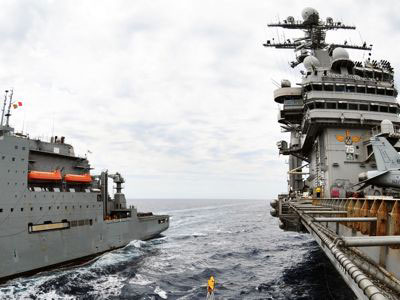The crossing of a U.S.-Israeli fleet through the Suez Canal should be interpreted less as a signal against Iran than a direct threat against Pakistan. True, it took place just after the Security Council vote on the Iranian sanctions, but it responds first and foremost to the gas agreement concluded between Tehran and Islamabad.

"Israel To Deploy Nuclear Submarines Off Iran Coast", headlined Israeli newspaper Haaretz on 22 June, reporting on an investigation by the British Sunday Times. According to a statement by an Israeli officer, one of the four Dolphin submarines provided by Germany is already positioned in the Gulf. With its cruise missiles equipped with nuclear warheads (1,500 Km range), Israel can reach any target in Iran. At the close of last week, an impressive naval squadron - consisting of more than a dozen U.S. warships and at least one Israeli missile launcher - crossed the Suez Canal on its way to the Persian Gulf: with a view to escalating military pressure on Iran. The reason is not only, as was reported, to prevent Tehran from acquiring nuclear weapons in future.
There is a more compelling factor: at the beginning of last week, Tehran signed a $7 billion agreement with Pakistan, inaugurating the construction of a gas pipeline from Iran to Pakistan. The project goes back 17 years and had, until now, been obstructed by the United States. Notwithstanding, Iran has already completed 900 Km of the 1500 Km-long gas pipeline, extending from the South Pars field to the border with Pakistan, which will build 700 Km more. As from 2014, 22 million cubic meters of Iranian gas will be delivered to Pakistan through this energy corridor on a daily basis. According to the original project, a branch of the pipeline was to arrive in India, but New Delhi withdrew for fear that Pakistan might interfere with the supply.
China, on the contrary, is ready to import gas from Iran: the China Petroleum Corporation signed a $5 billion agreement with Iran for the developpement of the South Pars field, replacing French company Total, whose contract was not renewed by Tehran (whereas the Italian ENI - Ente Nazionale Idrocarburi, Ndt - continues to operate in the South Pars and Darquain oil fields). For Iran, therefore, the project is of strategic importance: the country has the largest gas reserves after Russia and they are to a large extent still unexploited; through the energy corridor towards the East, Iran can thus elude the sanctions wanted by Washington. However, there is a weakness: South Pars, its biggest oil deposit, is located offshore in the Persian Gulf. It is therefore vulnerable to a naval blockade like the one the United States could impose by virtue of the sanctions adopted by the UN Security Council.
Washington is up in arms since Pakistan, its ally, signed the agreement with Iran just a few days after the sanctions were decided by the Security Council. Hence the military maneuvres, in line with Washington’s allies, particularly France. The aircraft carrier Truman, heading the naval squadron which is sailing towards the Persian Gulf, first made a stopover in Marseille, effecting an interoperability maneuver in the Mediterranean between 4 and 7 July which involved its 80 attack aircraft and the aircraft aboard the French carrier Charles de Gaulle. And, on 14 July, while en route to the Suez Canal, Truman received the visit of the Geman Defence Minister and Navy Chief of Staff.
The most exciting moment occurred on 13 June when in the chapel of the Truman, a French Catholic priest and a rabbi officiated a religious ceremony allowing "the two allied countries to unite on the spiritual level".
Source: Il Manifesto

 Articles by this author
Articles by this author Send a message
Send a message

















Stay In Touch
Follow us on social networks
Subscribe to weekly newsletter